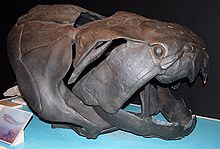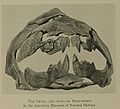Dunkleosteus
| Dunkleosteus Temporal range: Late Devonian
| |
|---|---|

| |
| Scientific classification | |
| Kingdom: | |
| Phylum: | |
| Subphylum: | |
| Class: | |
| Order: | |
| Family: | |
| Genus: | Dunkleosteus Lehman, 1956
|
| Species | |
| Synonyms | |
| |
Dunkleosteus is one of the largest arthrodire placoderms to have ever lived. This carnivorous predatory prehistoric fish lived in the late Devonian period, about 360 – 415 million years ago. The largest specimens are estimated to have reached lengths of 12 m.
however, the largest specimens with complete fossil prove is only 6 m (20 ft), and were probably the apex predators of their time.
Description
This section's tone or style may not reflect the encyclopedic tone used on Wikipedia. (March 2008) |
Dunkleosteus, named to honour David Dunkle, former curator of Vertebrate Paleontology at the Cleveland Museum of Natural History, was one of the largest members of the Placodermi, a Class of armour-plated fishes. The Placodermi first appeared in the Silurian, and the group became extinct during the transition from the Devonian to the Carboniferous, leaving no descendants.
Due to its heavily armoured nature, Dunkleosteus was likely a relatively slow (albeit powerful) swimmer. It is presumed to have dwelled in diverse zones of inshore waters, although it is unknown whether or not it was also somewhat pelagic, that is, swimming freely in open ocean. Fossilization tends to have preserved only the especially armoured frontal sections of specimens, and thus it is uncertain what exactly the hind sections of this ancient fish were like. As such, the reconstructions of the hindquarters are often based on related, albeit smaller, arthrodires.

The most famous specimens of Dunkleosteus are displayed at the Cleveland Museum of Natural History. Others are displayed at the New York Museum of Natural History and in the Queensland Museum in Brisbane, Queensland (pictured).
Instead of teeth, Dunkleosteus possessed two pairs of sharp gnathal plates which formed a beak. After studying a biomechanical model of the fish's jaws, scientists at the Field Museum of Natural History and the University of Chicago concluded that Dunkleosteus had the most powerful bite of any fish, well ahead of sharks, including the great white shark. Dunkleosteus could concentrate a pressure of up to 8,000 pounds-force per square inch (55 megapascals) at the tip of its mouth, effectively placing Dunkleosteus in the league of Tyrannosaurus rex and modern crocodiles as having the most powerful known bite. A 2007 study of the biomechanics of D.terreli, interpreted fossil jaws to build a computer model of the fish's bones and muscles and determined that it could tear apart its food with a force of 4400 newtons at the tip of the jaws, and had a maximum bite force of more than 5300N at the back of the dental plates.[1] Dunkleosteus could also open its mouth in one-fiftieth of a second, which would have caused a powerful suction that pulled the prey into its mouth, a food-capture technique reinvented by many of the most advanced teleost fishes today.
The discovery of Dunkleosteus armor with unhealed bite marks strongly suggest that they cannibalized each other when the opportunity arose. Frequently, fossils of Dunkleosteus are found with boluses of fish bones, semi-digested and partially eaten remains of other fish. As a result, the fossil record indicates that it may have routinely regurgitated prey bones rather than digesting them.
Some have suggested that placoderms such as Dunkleosteus were outcompeted by the smaller, swifter fishes, such as the early shark Cladoselache.[citation needed] However, others have pointed out that this assessment fails to take into account that predatory placoderms would have inhabited different ecological niches than the early sharks during the Devonian period.[citation needed]
Dunkleosteus, like most other placoderms, may have also been among the first vertebrates to internalize egg fertilization, akin to the modern process of vivipary as seen in some modern sharks. The first recorded sexual dimorphism appeared in the middle-Devonian ptyctodontid placoderm Rhamphodopsis, which had external clasping organs on males that are strong indicators of intromittent sexual intercourse and internal fertilization. Claspers are modified structures at the base of the pelvic fins which transmit sperm directly inside the female. Females had wide pelvic basal plates. See Placoderm and Ptyctodontida.
Dunkleosteus remains have been found in late Devonian strata in Morocco, Belgium, Poland, and North America.
In popular culture

- Dunkleosteus was the main apex predator of the fifth most dangerous sea in Sea Monsters. The show counted down the top 7 most dangerous seas in history. Dunkleosteus was depicted as being canniballistic and capable of bending metal.
- In the Dinotopia books and movies a massive Dunkleosteus guards the underwater entrance to the subterranean caves that contain the strutters and sunstones.
- The Devonian predator also made a brief appearance in the video game ParaWorld.
- In the video game E.V.O. Search For Eden, Dunkleosteus appeared as an enemy creature in the first time period, and the player could evolve its jaws and body, both being the strongest in those categories.
- China Miéville's novel The Scar features Dunkleosteus, where they are also referred to as "bonefish".
- In Ecco the Dolphin, Dunkleosteus appeared as an enemy in the prehistoric levels. Ironically the Dunkleosteus existed in the Devonian period and the prehistoric levels takes place 55 million years ago. They were already extinct during that time. Even its echolocation sprite resembles a shark.
References
- ^ Anderson, P.S.L. and Westneat, M.W. (2007). "Feeding mechanics and bite force modelling of the skull of Dunkleosteus terrelli, an ancient apex predator." Biology Letters, 3(1): 76-79.
External links
- Introduction to the Placodermi: Extinct Armored Fishes with Jaws. Waggoner, Ben (2000). Retrieved Aug 1, 2005
- Dunkleosteus sp. Placodermi. The Virtual Fossil Museum (2002). Retrieved Aug 1, 2005
- News articles
- MSNBC: Prehistoric fish packed a mean bite
- BBC: Ancient 'Jaws' had monster bite
- Courier Mail: Jaws of death
- CBC: Interview with Philip Anderson on Dunkleosteus Terrelli
- ABC News: Giant prehistoric fish packed quite a bite




